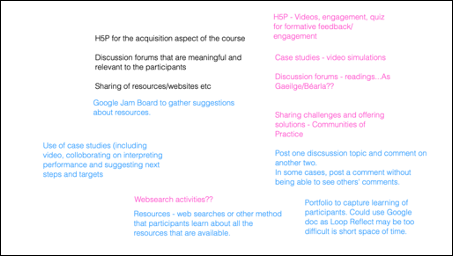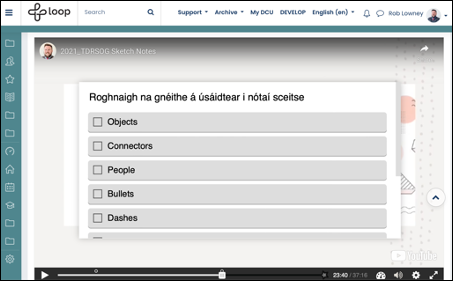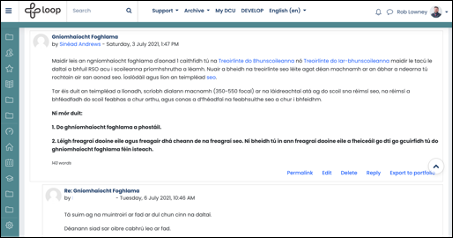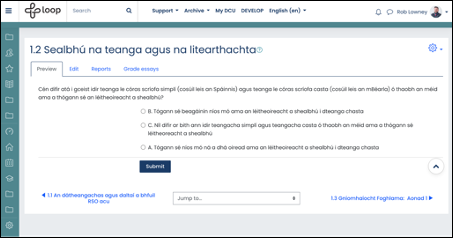
Using ABC to design a short CPD course for Irish Educators
| Case study authors | Rob Lowney & Sinéad Andrews |
| What is the title of the programme/ module/course that was the focus of your ABC Learning Design workshop? | Ag tacú le daltaí a bhfuil riachtanais speisialta oideachais acu sa chóras lán-Ghaeilge / Supporting pupils with special educational needs in the all-Irish system (“TDRSOG”) |
|
What are the programme lead name(s) and email?
|
Dr Sinéad Andrews (sinead.andrews@dcu.ie) |
| What is the mode of delivery of this programme/module/course (e.g. block release/blended/fully online)? | Fully online, asynchronous short 20 hour CPD course for teachers available for one month during the summer. |
| What discipline is it associated with? | Education. Primary and post-primary. Special education. Irish medium schooling. |
| What is the level of the programme/module/course? | This is a short CPD course for primary and post-primary teachers, recognised by the Department of Education and Skills (DES). It equates to approximately 20 hours’ work. It is audited by a DES inspector. Learners who successfully meet the requirements of the course are eligible to take 3 extra personal vacation days during the forthcoming school year. |
| What is the typical cohort size? | 25 |
What was the main learning and teaching challenge you faced when you requested an ABC Learning Design Workshop?
The impetus for the course arose out of a research study led by a team from the School of Inclusive and Special Education in the DCU Institute of Education. That study sought to capture the experiences of teachers teaching pupils with special educational needs (SEN) in the Irish medium school sector where students are taught exclusively through the Irish language. The team decided thereafter to develop a CPD course in this area to support this cohort of teachers and got approval from DES to do so. Many of these DES CPD courses are online. Coupled with the pandemic restrictions it was decided to run this course online too. The team is well experienced in teacher education, and had good digital skills from the extended remote teaching context of the pandemic, but was not certain how to design a good quality, fully online, asynchronous short course that also meets all of the DES requirements. This is when the team reached out to the Teaching Enhancement Unit (TEU) for learning design guidance. Previously, the team lead had engaged in professional learning with the TEU as part of the Enhancing Digital Teaching and Learning project, so a working relationship was already there, which provided a good foundation. A challenge that the team faced was designing interesting and student-centred learning opportunities that would engage the learners throughout the short duration of the course.
When was the workshop held?
An online ABC learning design workshop was held in late February 2021. Most of the course team attended and it was facilitated by two TEU staff, an academic developer and a learning technologist. It was held entirely over Zoom and lasted about two hours. There were polls based on ABCs Six Learning Types to get the team thinking about different learning activities within Loop (Moodle), breakout room discussions to compare ideas, and a course storyboard was commenced.

Fig. 1 Summary whiteboard of breakout room discussions
After the workshop, what happened? For example, did your team further develop the storyboard? Did you meet further to discuss action items?
The team continued to meet regularly after the ABC workshop to finalise the storyboard and begin the development process. The storyboard really helped in structuring the material and flow of the course. It also proved a useful document when applying to DES for course recognition, as it was easy to show them all that was involved in the course. As a team we used the storyboard and we also used the different colour-coded activities to ensure that we had a learner centred approach. We filled out the board with our ideas and the colour coding helped us to ensure that we incorporated all of the required elements.
What may have helped or hindered storyboard development after the workshop?
It helped that the team was well-established, having previously collaborated on the research study, and having committed to the development of the course. It helped enable a collaborative atmosphere. It was good that we as a team had a list of possible topics for inclusion from the research that took place prior to the course design process. It shortened the process and helped us make design decisions based on the needs of the teachers undertaking the course.
What changes (if any) were made to the course/module or programme as a result of the ABC Learning Design workshop?
As this was a new course, to be delivered online, the ABC Learning Design workshop was really important to get the team thinking about the best mix of content and activities to provide to learners. In particular it got the team thinking about creating interactive material using H5P, and in thinking about good activities to engage the learners online, rather than simply presenting lots of activities. Because the course would be asynchronous, online, and delivered through the medium of Irish, the team were prompted to think about the practicalities of preparing audiovisual materials, transcripts, subtitles, translations and so on.

Fig. 2 Screenshot of H5P interactive video
How have any changes or innovation(s) introduced as a result of the ABC workshop worked (to date) with your students? For example, have they helped students achieve the learning outcomes more successfully? Or have they not worked as well as originally anticipated?
The course ran during July 2021. As it was online and asynchronous, learners could complete it at any point during that period. The learners that did complete it found it engaging and found that they met the intended outcomes.
What tips do you have for other educators implementing such practice(s)?
The scale of the course design will impact the possibilities for development, so it is important to be mindful of that. When this workshop took place in February, the team initially considered creating a lot of interactive H5P content. However, as ‘the day job’ got more busy as the semester progressed, there was not as much development time available to create the breadth of H5P material initially envisaged - particularly because it does take quite some time to use that tool. In the end we compromised and had a variety of H5P interactive content as well as some Loop Lesson content, which comprised text, video and questions.
When running an online course, it is important to be clear with learners about how to use the platform. Although the course was laid out well, with clear sections, and numbered activities, some learners had difficulty understanding how to post in a discussion forum, for example, so some additional instructions had to be posted for them. When developing this course the team realised that having a consistent format throughout the online course was important for student accessibility and effective course delivery.

Fig. 3 Screenshot of discussion forum activity

Fig 4. Screenshot of Loop Lesson activity comprising audio, text and video

Fig 5. Screenshot of Loop Lesson embedded questions
What about future plans for this programme/module/course regarding blended or online learning?
This course was developed as a Department of Education approved summer course. At present the team is looking for a way to deliver this course to teachers in other formats such as CPD throughout the school year. The content of the course also has implications for other immersion and bilingual education sectors and the team are currently looking at how the content can be adapted and delivered to teachers in these sectors.

Copyright
You are free to share and/or adapt this material in any medium or format, but you must give appropriate credit, provide a link to the license, and indicate if changes were made. You may do so in any reasonable manner, but not in any way that suggests the licensor endorses you or your use. You may not use the material for commercial purposes.
